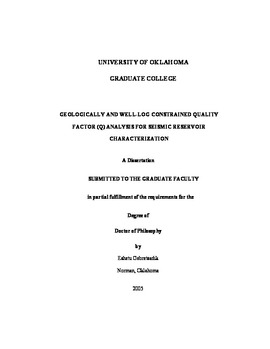| dc.contributor.advisor | Pigott, John D., | en_US |
| dc.contributor.author | Gebretsadik, Eshetu. | en_US |
| dc.date.accessioned | 2013-08-16T12:19:52Z | |
| dc.date.available | 2013-08-16T12:19:52Z | |
| dc.date.issued | 2005 | en_US |
| dc.identifier.uri | https://hdl.handle.net/11244/897 | |
| dc.description.abstract | Measurements of P- and S-wave velocities are conducted on alternating layers of acrylic and aluminum. In this experiment, both thickness of the layers, and frequency of the propagating wave are varied. Based on these observations, for wavelength/thickness (lambda/d) >> 1, the medium behaves as a transversely isotropic medium, and for (lambda/d) < < 1 the medium; is represented by individual homogeneous pieces. Velocity dispersion is minimal in both cases. However, when (lambda/d) is between the two extreme cases there is a significant velocity dispersion due to interbed multiple scattering. | en_US |
| dc.description.abstract | The principal objective of this work is to answer the problems following questions: (1) Can one extract Q directly from 2D reflection seismic in a way? (2) Can the attenuation of a plane wave propagating through a medium be accurately quantified? (3) What are the factors that complicate the measurement of attenuation from a propagating plane seismic wave? (4) How does quality factor (Q) affect the near and far offset trace attenuation? (5) Can one design a forward model that can effectively resolve effects of the complicating factors? (6)What is the significance of measuring attenuation due to anelastic rock properties? | en_US |
| dc.description.abstract | A forward model using 2D reflection seismic is used to observe effects of different values of Q and of offset on the seismic wavelet, both in the time domain and frequency domain. The result indicates Q inversely affects amplitude decay (i.e. the higher value of Q, the smaller the amplitude decay), while offset directly affects amplitude decay. In addition, preferential attenuation of the higher frequency content is prevalent, but phase distortion is not observed. | en_US |
| dc.description.abstract | P- and S-wave velocities, Qp and Qs were measured on 46 core samples collected from Well C-276, La Concepcion Field, Lake Maracaibo Venezuela. Measured Vp/Vs and Qp/Qs are correlated with petrophysical properties such as porosity and permeability of the core samples. QpQs has shown a very good relationship with porosity and permeability. Finally, Q is estimated from a CMP-gather extracted 3D survey from La Concepcion Field, Venezuela. The computed Q values are correlated with Q values from the well, and there is a very good relationship between the two. Furthermore, all Q measurements show correlation with the porous and permeable layers. Therefore, properly measured Q can be used together with other geophysical methods in reservoir characterization. | en_US |
| dc.format.extent | xv, 154 leaves : | en_US |
| dc.subject | Seismic waves. | en_US |
| dc.subject | Seismic reflection method. | en_US |
| dc.subject | Geophysics. | en_US |
| dc.subject | Geology. | en_US |
| dc.subject | Quality factor meters. | en_US |
| dc.title | Geologically and well-log constrained quality factor (Q) analysis for seismic reservoir characterization. | en_US |
| dc.type | Thesis | en_US |
| dc.thesis.degree | Ph.D. | en_US |
| dc.thesis.degreeDiscipline | Conoco Phillips School of Geology and Geophysics | en_US |
| dc.note | Source: Dissertation Abstracts International, Volume: 66-05, Section: B, page: 2470. | en_US |
| dc.note | Adviser: John D. Pigott. | en_US |
| ou.identifier | (UMI)AAI3174451 | en_US |
| ou.group | Mewbourne College of Earth and Energy::Conoco Phillips School of Geology and Geophysics | |
